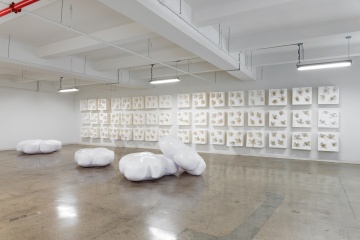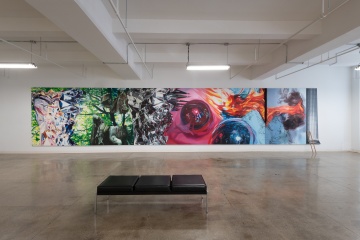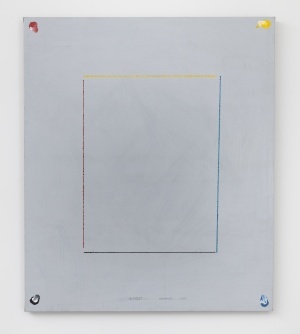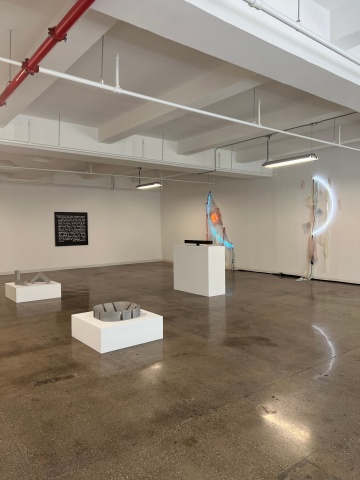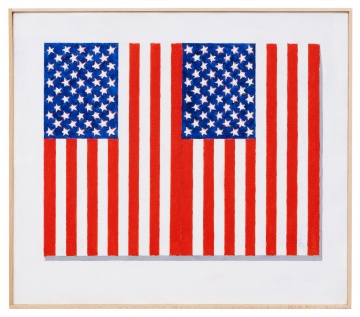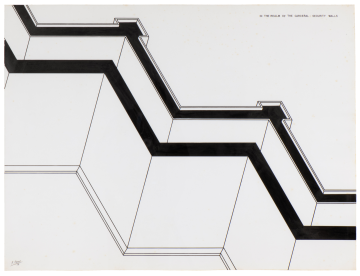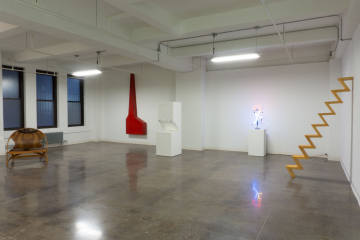Castelli Gallery
18 East 77th Street, 3rd Floor
New York, NY 10075
212 249 4470
Also at:
24 West 40th Street
New York, NY 10018
212 249 4470
New York, NY 10075
212 249 4470
Also at:
24 West 40th Street
New York, NY 10018
212 249 4470
Works Available By:
Noriko Ambe
Noriko Ambe
Arakawa
Richard Artschwager
Hanne Darboven
Dan Flavin
Jasper Johns
Diana Kingsley
Joseph Kosuth
Roy Lichtenstein
Robert Morris
Bruce Nauman
Claes Oldenburg
Richard Pettibone
Robert Rauschenberg
Edward Ruscha
Keith Sonnier
Mike and Doug Starn
Frank Stella
Cy Twombly
Andy Warhol
Lawrence Weiner
Noriko Ambe
Noriko Ambe: State of Flow, Andy Warhol "Flowers", Leo Castelli, 1964
November 12, 2024 - January 17, 2025
Sixty years ago, Andy Warhol opened his first exhibition at Leo Castelli at 4 East 77th Street. Titled Andy Warhol. Flower Paintings, the exhibition presented a wall in which twenty-eight small paintings were displayed very close together in a 4 x 7-foot grid. The flower petals ranged in color and were a stark contrast against the grey grass in the foreground.
In 2020, artist Massimo Barzagli wrote about the exhibition and noted that it was not a coincidence that Warhol chose to present the exhibition in 1964, “The Vietnam War is in full swing and many young people, who had left for service in the mid 1950s are returning home as martyrs.” Flowers can be both decorative and commemorative, and while at first glance Warhol’s exhibition may appear as just a simple pleasantry, one can also look at it as a memorial for the young Americans who lost their lives in Vietnam.
The exhibition signaled the beginning of a long collaboration between Andy Warhol and Leo Castelli. To remember it, Castelli Gallery invited artist Noriko Ambe to reflect on the show and create a response to the exhibition on its sixty-year anniversary.
Using black and white images from the gallery’s archive as a reference, Ambe reproduced the original canvases in four different ways. The depths of color are depicted in varying shades of grey in the archival photography and to symbolize this, Ambe layered sheets of Yupo paper of varying thickness. Each sheet of Yupo paper is intricately cut to express the way the shape of the flower is inverted as hollow. This ultimately transforms the shape of the flowers, which repeat like mirror images, into a void-like presence. Therefore, Warhol’s lively colors are replaced by emptiness and white, repeating the message of beauty in flowers and a sense of loss.
Additionally, the artist created three cutting and pasting books and was largely influenced by the political environment at the time of the 1964 show. As Ambe states, “I thought about historical perspectives and aimed to create an exhibition with a multi-layered interpretation in a contemporary context by expressing this complexity through the medium of paper cutting and books.”
Keith Sonnier
Keith Sonnier: Drawings
September 17, 2024 - October 25, 2024
Keith Sonnier was a prolific draftsman. Drawing was the foundation of his art, the mainstay of his mercurial and diverse creativity. Keith Sonnier: Drawings focuses on a selection of drawings made between 1966 and 1970, the earliest of which are from the artist’s time as an MFA student at Rutgers University.
Many of the ephemeral and inflatable works in Sonnier’s thesis exhibition are easily recognizable as three-dimensional forms in these preliminary drawings, collectively titled the Early Rutgers and File Series, both from 1966. Unusually formal, precise even in their execution and composition, they are remarkable in that they are among only a few of his drawings to utilize perspective.
Sonnier alternated between significantly different series of work which is reflected in his drawings. Freehand line drawings articulated the form and the materials such as transformers, wires, silver tipped light bulbs in the earliest light works like Neon Wrapping Lightbulbs, circa 1967. The organic loops and undulating lines in the drawings, which are made with markers on plain paper or ballpoint pen on red graph notepads, were translated into flexible copper (with dimensions similar to those of neon tubes) thus making perfect templates, providing the sculptor with full-size maquettes, and the neon fabricator with three-dimensional “drawings in space” to work from.
Plain, loose-leaf sketch pads, or notebooks with graph paper, provided a framework for the straight lines, circles and squares seen in Sonnier’s glass and neon work that began in his Mulberry Street Studio such as Ba-O-Ba and Early Glass and Neon. The free-form neon loops and low-tech materials of the Neon Wrapping Lightbulbs series were replaced by the rigid geometry of the Ba-O-Ba’s, 1969-2019. This major series of work may have begun with thumbnail sketches but over the course of fifty years evolved in both scale and concept to include sculptures and architectural installations whose symmetry and proportions were inspired by the concept of the golden ratio and sacred geometry.
During the early 70’s, Sonnier switched gears completely, moving away from sculpture and instead immersing himself in the possibilities offered by the latest technology. This investigation took his work in new directions for almost a decade. The drawings that bring this exhibition to a close relate specifically to the experimental film and video work documented in the Castelli Sonnabend Videotapes and Films, 1974. Sketches and drawings such as the Electrical Cut Studies, 1970, focus on the positioning of video equipment and the manipulation of video editing techniques.
Keith Sonnier was born in 1941 in Mamou, Louisiana. He had his first solo show at Castelli Gallery in 1970. He died in Southampton, New York in 2020. This November, Dia will open Keith Sonnier, a long-term presentation which includes works from the 60s and 70s.
Joseph Kosuth, Keith Sonnier
Joseph Kosuth / Keith Sonnier
June 10, 2024 - July 18, 2024
Castelli Gallery, 24 West 40th Street, is pleased to present Joseph Kosuth / Keith Sonnier, an exhibition that brings together the work of two artists who have been associated with Castelli Gallery since the beginning of their careers.
Joseph Kosuth’s ‘Titled (A.A.I.A.I.)’ [Exterior-Interior] (Ety.), 1967, is an example of the artist’s “definition” works that are based on borrowed language. The work is made up of seven mounted photographs and is the only seven-part work that the artist made from this series. In this work, Kosuth goes a step further by using an etymological dictionary, which further exemplifies the iconic idea of language borrowed from dictionaries.
Perhaps the most “conceptual” part of the work is the notion of when the work is dated, or rather how it should be dated. Kosuth’s work is largely dated at the date of conception, in this case, 1967; yet it was not fabricated until decades later. In this way, it is difficult to answer the question if the work is “original.” Similarly to ‘Titled (A.A.I.A.I.)’ [Exterior-Interior] (Ety.), Kosuth’s R.M. #1, 1992, is composed of a rectangular piece of glass lying on an aluminum shelf and 1992; however, the original sheet of glass from 1992 is not required when exhibiting the work, but rather can be fabricated at any time. The text displayed on the glass relates to the relationship between art and language with the viewer.
While Joseph Kosuth’s works focus on language, Keith Sonnier’s Ba-O-Ba Fluorescent, 1970, is largely ephemeral. Composed of foam, neon light with fluorescent powder, and glass, the work was included in the artist’s first solo exhibition at Castelli Gallery in 1970 at Castelli Warehouse. Ba-O-Ba Fluorescent is an example of Sonnier rejecting traditional mediums for sculpture such as bronze and marble in favor of materials that are psychologically loaded, like reflective glass and foam. Both ‘Titled (A.A.I.A.I)’ [Exterior-Interior] (Ety.), R.M. #1, and Ba-O-Ba Fluorescent, comment on the idea of what is an original artwork and defy the traditional ideas of fine arts.
Joseph Kosuth was born in in Toledo, Ohio in 1945. He lives in New York and Venice, Italy.
Keith Sonnier was born in Mamou, Louisiana in 1941 and passed away in Southampton, New York in 2020. His upcoming long-term presentation, Keith Sonnier, opens at Dia Beacon in November 2024.
James Rosenquist
James Rosenquist: The Holy Roman Empire through Checkpoint Charlie
January 16, 2024 - May 24, 2024
Castelli Gallery is pleased to present James Rosenquist, The Holy Roman Empire through Checkpoint Charlie. Nearly forty feet long, Rosenquist’s painting The Holy Roman Empire through Checkpoint Charlie, 1994, encompasses his commentary on both history and politics. This monumental work was first exhibited at Leo Castelli Gallery in October 1994.
Rosenquist was galvanized by his visit to Berlin after the fall of the Berlin Wall in 1989, and following his return home he began to work on this singular painting. He was largely affected by the difference he saw between the East and the West, and particularly struck by the barren wasteland in East Berlin. Especially compelling to him was his encounter with the historical crossing point of the Berlin Wall known as Checkpoint Charlie.
The center of the painting is dominated by a large and intense red eye. While it is impossible to know what the eye stands for, after consulting sources made available from the archive of the artist, it may symbolize the relation to the Russian occupation zone in East Germany at the end of War World II.
In the left area of the painting is a sizable image of a what at first glance looks like a knight on a horse, moving triumphantly, and partially disappearing through a landscape of trees. In reality, this image depicts King Frederick the Great, under whose leadership Prussia became one of the greatest states in world history. The image is taken from the Daniel Rauch sculpture Equestrian Statue of Frederick the Great, 1851, located on the Unter den Linden, named for linden, or lime trees, the avenue in Berlin which was the main focal point of social and cultural life before World War II.
On the right side of the painting, Rosenquist has drawn the figures from Nike Instructs the Boy in Heroic History, Emil Wolff’s 1847 sculpture located on the Schloßrücke, a bridge in the central Mitte district of Berlin. Nike, the Greek goddess of victory, is showing the young boy the names of the “Great” victorious generals of the past: Alexander III, Julius Caesar, and Frederick II. While it is an edifying image, one is struck by the artist’s decision to depict Nike’s wings on fire, alluding to the tragedy these conquerors brought with them. Rosenquist’s mounting of a burnt piece of wood onto the canvas creates a dichotomy between the pretend, painted fire and the actual object destroyed by it.
On the right edge of the canvas is a column taken from the Brandenburg Gate, originally commissioned by Frederick the Great in the 1700s. Surprisingly, Rosenquist breaks from the linear composition of the canvas and instead shapes the bottom of the canvas to simulate the shape of the column’s pedestal, which gives the impression of being in front of the actual column and looking at it from below. This reference to the Brandenburg Gate symbolizes the division between East and West, or perhaps as a sign of future accord.
Rosenquist breaks away from traditional painting by adding an actual object, a small-scale ladder, which leans against the painted column. The size of the ladder exemplifies Rosenquist’s use of perspective as it is minute in comparison to the column and the immense size of the artwork. It is indeed the size that makes us see the ladder as unreal, an allegory for crossing from East to West or even actually attempting it, should one have acquired the tools to do so. The ladder portrays a final moment of negativity seen throughout the artwork, yet also suggests there may be a small glimmer of hope.
Arakawa
Arakawa: A Line Is a Crack
September 7, 2023 - November 22, 2023
After a period in the late 1950s in which Arakawa was active in the Tokyo avant-garde art circles, he arrived in New York City in December 1961 and enrolled in the Brooklyn Museum Art School. Upon his arrival, Arakawa first lived in Yoko Ono’s loft at 112 Chambers Street. Ono’s TriBeCa loft was a fixture in the New York art scene and was well-known for having hosted the Chambers Street Loft Series, which she presented together with composer La Monte Young between December 1960 and June 1961. Already living in the loft, was artist Robert Morris, whom at the time was married to dancer Simone Forti. When the two broke-up, Ono offered Morris to temporarily live at Chambers Street, as she was not occupying the space.
It was through this connection with Robert Morris, that Arakawa had an entrée into the New York art scene. Arakawa joined the group of young New York artists, including Jasper Johns, Robert Rauschenberg, and Morris himself, whose work was largely influenced by Marcel Duchamp, and was ultimately breaking the boundaries of traditionally conceived painting and sculpture. In this context, Arakawa met Virginia Dwan. Beginning in 1964, Arakawa showed his work with the Dwan Gallery until it's closure in 1971. Throughout this period, Arakawa had five solo exhibitions with Dwan, both in Los Angeles and New York.
Arakawa: A Line is A Crack focuses on Arakawa’s work from the 1960s. The exhibition reflects the liveliness of the New York art scene at the time, as well as the aspiration to think of painting in a new way. Beginning in 1962, Arakawa conceived of paintings that were very minimal, as seen in Forming of Untitled, which consists of a white canvas with four graphite marks. In these early works, Arakawa appears to make “tabula rasa” of all his previous knowledge of conventional painting.
Starting in 1963, Arakawa introduces figuration into his work, moving in a direction that showcases the relation to the work of Johns and Rauschenberg. Images of everyday objects are transferred to the canvas using airbrush acrylic with the technique of spray paint, as seen in Untitled, 1964. Within this group of work, Untitled, 1964-65, is particularly complex. In addition to transferring images with spray paint, Arakawa mounts the actual objects on top of the canvas: a funnel and an umbrella. He introduces the use of photography by borrowing contact sheets from Eadweard Muybridge’s Getting into Hammock.
What is a painting? What is a sculpture? Does a painting become a sculpture if the artist cuts a corner of the canvas and in the process turns the work from two-dimensional to three-dimensional? Like we see in Arakawa and I…, 1967, Arakawa’s work ultimately raises these questions but fails to provide answers.
The title of the exhibition, A Line is A Crack, takes inspiration from a text written by Madeline Gins, Arakawa’s partner in life and in work. Arakawa references “A Line is A Crack” in Landscape, a work from 1967.
Joseph Kosuth, Robert Morris, Keith Sonnier
Joseph Kosuth, Robert Morris, Keith Sonnier: Works from the 60's
May 16, 2023 - June 29, 2023
Castelli Gallery, 24 W 40, is pleased to present a group exhibition with works by Joseph Kosuth, Robert Morris, and Keith Sonnier.
The works are realized in a variety of sizes and mediums; yet, they exemplify the long-standing relationship of the artists and the gallery.
Joseph Kosuth’s Titled (Art As Idea As Idea), 1966, is an exemplary work of the artist’s iconic definition pieces. The work is made via Photostat. In the case of Titled (Art As Idea As Art), the artist is appropriating an old French dictionary’s definition of “Black” or “noir.”
The exhibition includes the complete set of six multiples that Robert Morris realized in the early 1970s, based on his small object from 19601-1964. Among them, Photo Cabinet , 1962-1975 is of special importance because the original work from 1962 is now destroyed. The work consists of a small box, with a door. When you open the door, you see an image of the box and have the illusion that you can keep opening doors. Other works, like 3Ls and Wedges, reproduce in small size some of Morris more iconic Minimal works.
Keith Sonnier’s Demi-Lune, 1968/2013, and Untitled (Also: Neon and Cloth), 1968/2012 are two examples of the artist’s ephemeral works from the late 1960s. The use of neon and, in particular, of cloth challenge the traditional concept of sculpture, as an object made with materials which, such as marble or iron, and meant to endure the passage of time.
Joan Jonas and Eiko Otake
Joan Jonas and Eiko Otake: Drawing in Circles
March 14, 2023 - April 1, 2023
Castelli Gallery, in partnership with Danspace Project, is pleased to present Joan Jonas and Eiko Otake, Drawing in Circles. The exhibition will run from March 14th to April 1st at the gallery location on 24 W 40th Street.
Drawing in Circles offers a unique insight into the artists’ processes of choreography and performance, that includes improvisation, collaboration, space, sound, object, and time. The installation will include two videos, one done by each artist, that the artists’ assembled to mark this historical collaboration. Additionally, the collaborative video, With the Earth at My Waistline, first presented in 2021, will also be on display.
During the run of the exhibition, there will be three live performances titled Drawing in Circles WHY. The performance will reference the artists’ connection and inspiration to Japan, particularly the influence of Nō. Drawing in Circles WHY marks a significant collaboration between Jonas and Otake as their first public performance. The performances will take place on March 18th at 4 pm, March 24th at 7 pm, and March 25th at 4 pm.
Reservations are required for performances. For more information and to reserve tickets, please refer to Danspace Project’s website.
Joan Jonas was born in 1936 in New York. After studying sculpture, Jonas became interested in dance and considered one of the founders of performance art. Her videos were included in the Castelli/Sonnabend Videotapes and Films (CSVAF) division of Castelli Gallery in 1974. Jonas’ work has been marked by historical exhibitions worldwide. She will have a retrospective at the Museum of Modern Art, New York next year. Jonas currently lives and works in New York.
Eiko Otake was born in 1952 in Japan and moved to New York in 1976. In 1972, she began performing under the duo Eiko & Koma, having performed at museums and festivals around the world. Since 2016, Otake has performed on her own. She teaches interdisciplinary courses at NYU, Wesleyan University, Colorado College and UCLA that implement readings, environmental issues and movement study. She currently lives and works in New York.
Joseph Kosuth
Joseph Kosuth: 'Fort! Da!' (Old Work)
January 10, 2023 - February 25, 2023
Castelli Gallery is pleased to present Joseph Kosuth: ‘Fort! Da!’ (Old Work). The exhibition will run January 10th to February 25th, 2023 at the gallery location on 24 W 40th Street.
Joseph Kosuth first exhibited ‘Fort! Da!’ in 1985 at Castelli’s 420 West Broadway location. The upcoming exhibition consists of two works included in the historical exhibition and an additional work conceived at the time but never realized until now.
‘Fort! Da!’ references a game Sigmund Freud recounts in Beyond the Pleasure Principle, 1920, in which Freud describes his grandson throwing a toy and retrieving it while exclaiming Fort! (Gone!) and Da! (Here!). In Kosuth’s exhibition, the viewers face large scale photographs reproducing the gallery space. The photographs have black frames, incorporate elements of text and various colored crosses, and they are installed on the opposite wall they depict. Therefore, the viewers are invited to participate in a variation of the game Freud describes, in which the space seems to appear and disappear in front of them. As Kosuth states: “I have always considered the ‘spectator’ to be an important part of the making process. My work never, I believe, pandered to the presumptions of the viewer–in fact, I feel that the ‘making process’ hinges on rupturing those presumptions.”
‘Fort! Da!’ revisits what Kosuth refers to as the ‘form of presentation’ in his early works. The large-scale photographs, like the photograph of the chair in Kosuth’s iconic ‘One and Three Chairs’, 1965, are intended to be taken with each new installation, as they reproduce the space in which the artwork is installed. This ultimately disrupts the expectation of permanence which has traditionally been attached to objects of art. In ‘Fort! Da!’ this is further emphasized through the use of the heavy black wooden frames. While these “frames” may give the impression that the artworks can be simply taken down from the wall, in reality, they are affixed to the wall and do not serve any practical function beyond that of creating an illusion of a conventional work of art.
Joseph Kosuth has been strongly influenced by the narrative and discourse of psychoanalysis. During the 80s he produced several series of works referencing Sigmund Freud. In addition to ‘Fort! Da!’,‘Zero & Not’, ‘Cathexis’, ‘Hypercathexis’, and ‘Intentio’ reside, as Kosuth said, “within the Freudian landscape.” In addition, Kosuth has appropriated and re-worked several of Freud’s texts in installations, special projects and site-specific works.
Joseph Kosuth was born in 1945 in Toledo, Ohio. He had his first exhibition at Castelli Gallery in 1969 and has since maintained a working relationship with the gallery. He currently lives and works between New York and Venice, Italy.
For further information, please contact Chloe Greisman at chloe@castelligallery.com.
John Chamberlain, Hanne Darboven, Jasper Johns, Robert Morris, Mike and Doug Starn, Lawrence Weiner
FAR AWAY and CLOSE
September 29, 2022 - November 23, 2022
Castelli Gallery, 24 West 40th Street, is pleased to present FARAWAY and CLOSE, a group exhibition with works by John Chamberlain, Hanne Darboven, Jasper Johns, Robert Morris, Mike and Doug Starn, and Lawrence Weiner.
The works in the exhibition are realized in a variety of sizes and mediums. Yet, a shared interest in the concept of location, intended both as physical space and a space of mind is what brings them together.
Lawrence Weiner’s Untitled, 1999, a set of six works on paper, showcase the use of tangible space and direction; while the reoccurring phrase, “Caught by ships passing in the night” resonates a feeling of being lost in the metaphorical space. If the work reminds us of movement in space, Hanne Darboven 12 months with Postcards from Today of Horses, 1982, consisting of 12 framed pages of months from the 1982 calendar, remind us of movement in time. Additionally, Darboven’s collage shows her use of the word heute (“now”) seen across her oeuvre, which she proceeds to cross out, leaving the viewer unsure of the place in time.
A group of John Chamberlain’s collages from View from the Cockpit series show an improbable landscape, at the horizon, as improbable is the landscape in the Mike and Doug Starn photo-collage The No Mind Not Thinks solstil, 2013 and the drawing by Robert Morris 10 Mirrors in a Landscape, 1997. These abstract horizon lines portray an uncertainty in place as it relates to space and time.
Another work by Robert Morris, 1934 Mid-West Dust Storm, 2010, consisting of a drawing made of Epoxy on three aluminum panels, depicts a terrifying sand storm in the Mid-West, something dating from the time he was a child. This memory of things past reappears in two Untitled drawings by Jasper Johns, in which the artist is including the floorplan of the house where he spent part of his childhood and a reference to the four seasons. In both instances, these recalls in memory showcase the artists’ location at a specific time and place which allows them to return to them through drawing.
A location can be far away from us, or close. Above all, a location can be a place in the mind, and as such change constantly. Robert Morris Untitled (Location), 1963-1973, contains four mechanisms that requires the installer to manually change the distance depending on where the work is placed on the wall. By creating a work that has the ability to change depending on the space, it evokes a sense of no absolute location.
By bringing together this group of works, the exhibition hopes to bring attention to the similarities between physical space and time when compared to the figurative concept of space of mind.
For more information, please contact Chloe Greisman at chloe@castelligallery.com
Richard Pettibone
Richard Pettibone: The American Flag
April 1, 2022 - June 30, 2022
Castelli Gallery is pleased to present Richard Pettibone: The American Flag, an exhibition of fifteen new paintings that the artist realized between 2020 and 2021. The exhibition is taking place at the gallery’s midtown location, at 24 West 40th Street.
Richard Pettibone is one of the central figures of the discourse on Appropriation Art, which developed out of the Pop Art movement in the early 1960s. At the beginning of his career, Pettibone appropriated the work of artists who were his contemporaries, such as Andy Warhol, Roy Lichtenstein, Jasper Johns. As a source for his work, Pettibone used images printed in the pages of Artforum. The artist copied them faithfully, developing a technique that became his iconic style of making miniature versions of artworks.
With the new paintings, Pettibone returns to one of his most familiar subjects: Jasper Johns and the American flag. Several paintings in the exhibition are faithful appropriations of Johns’s work. Others elaborate on Johns, or are completely independent from Johns’s work. In this way, Pettibone is once again challenging one of the fundamental concepts of Western art: the idea of authorship and originality. In speaking about his work and the creative process that has guided him throughout his career, Pettibone says, “No matter how accurately you copy something, you can’t get rid of yourself. It’s just always you.”
Accompanying this exhibition is an illustrated catalogue.
Robert Morris
Robert Morris, In the Realm of the Carceral, 1978 with Giovanni Battista Piranesi
September 30, 2021 - December 17, 2021
In 1978, Robert Morris created a series of twelve black ink drawings titled, In the Realm of the Carceral, showing various details of prison architecture rendered as bold, linear graphics. Castelli Gallery is presenting eight drawings from the series. Alongside these works, the exhibition will include three works from Giovanni Battista Piranesi’s Carceri d’Invenzione, 1745-60, a well-known collection of etchings depicting the dark and labyrinthine interiors of imaginary monumental prisons, examples of which may have fascinated a young Morris visiting the Nelson-Atkins Gallery in his hometown, Kansas City.
Robert Morris emerged as one of the founders of the Minimal Art movement in the 1960s, which revolved around the Green Gallery in New York. He is also known for iconic Felt works, which were first shown at Castelli in 1968.
The 1970s were a decade in which many artists became committed to activism and politics. Morris was at the forefront of this effort, participating in the Art Workers Coalition, a protest group that launched a major critique of public museums’ political inaction and questionable corporate partnerships. Politics influenced Morris’s work as well, which increasingly explored themes of obedience, authority, submission, confinement, subjugation, and disorder.
This turn is clearly illustrated in Morris’s In the Realm of the Carceral, and critics have attributed to the Carceral drawings a threshold moment in Morris’s career. According to Branden Joseph, the Carceral drawings are “the series of works with which Morris’s minimalist project may be said to have ended.” Other writers, however, suggested that the drawings suggest a new way of interpreting the definition of Minimal Art. Regardless of this debate, Morris continued to engage with power, its various articulations in space, and its psychological effects on the viewer for the remainder of his career.
In his own time during the Italian Enlightenment and since, Piranesi is known as an artist whose work forges an interface between reason and imagination, order and feeling. Piranesi’s Carceri infuse his distinctive dramatic vaulted spaces with an alternative impression of Palladian Rome: an imaginary world of psychological and physical horror.
Piranesi’s etchings were also an influence on Michel Foucault’s influential text, Discipline and Punish: The Birth of Prison. Written in 1975 and translated into English in 1977, it is a fundamental book about prison, not only as a place to confine and isolate the body from society, but also as a condition of the mind. It is likely that Morris encountered Foucault’s writing during this time, and these readings may have reminded the artist of his earlier experience with Piranesi’s Carceri etchings, inspiring him to make his own Carceral drawings.
Accompanying this exhibition is an illustrated catalogue featuring an essay by art historian Miguel de Baca.
Noriko Ambe, Richard Artschwager, Joseph Kosuth, Roy Lichtenstein, Robert Morris, Kaz Oshiro, Richard Pettibone
Homestyle II
February 1, 2021 - May 30, 2021
Castelli / Sonnabend Videotapes and Films
From the Blog:
April 1, 2020 - May 31, 2020
During this time, Castelli Gallery will be focusing on blog posts, just released a new one about the Castelli / Sonnabend Videotapes and Films. We will be posting blog posts in the coming weeks on artists like Richard Pettibone and Joseph Kosuth, along with a previously unpublished interview with Leo Castelli.
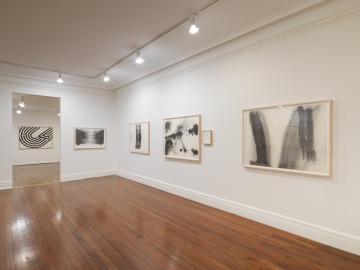
Robert Morris
Robert Morris: Voice, 1974
January 11, 2020 - March 28, 2020
The exhibition at 24 W 40 restages Robert Morris' audio installation "Voice" (1974) alongside preparatory drawings and diagrams. A selection of Morris’ "Blind Time" and "Labyrinth" drawings are displayed at 18 E 77 St.
Robert Morris
Robert Morris: Voice, 1974
January 11, 2020 - March 28, 2020
The exhibition at 24 W 40 restages Robert Morris' audio installation "Voice" (1974) alongside preparatory drawings and diagrams. A selection of Morris’ "Blind Time" and "Labyrinth" drawings are displayed at 18 E 77 St.
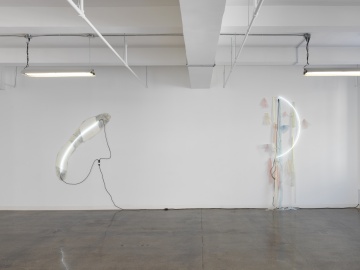
Keith Sonnier
Ethereal/Ephemeral: Keith Sonnier in the Sixties
September 20, 2019 - November 23, 2019
This exhibition focuses on ephemerality as a formative principle in Keith Sonnier’s work through a display of sculpture from the 60s and 70s which mark his initial engagement with this concept/quality.

Keith Sonnier
Ethereal/Ephemeral: Keith Sonnier in the Sixties
September 20, 2019 - November 23, 2019
This exhibition focuses on ephemerality as a formative principle in Keith Sonnier’s work through a display of sculpture from the 60s and 70s which mark his initial engagement with this concept/quality.
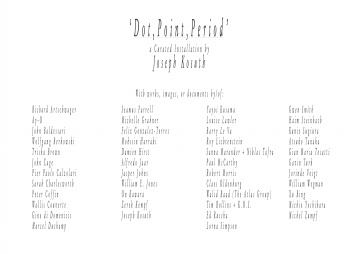
Joseph Kosuth
'Dot, Point, Period': a Curated Installation by Joseph Kosuth
April 4, 2019 - July 20, 2019
Castelli Gallery, 24 W 40th Street, is pleased to present ‘Dot, Point, Period’: a Curated Installation by Joseph Kosuth. Since the 1960s, Kosuth has used the “curated installation” as a key conceptual/aesthetic strategy for exploring questions of authorship and the basic nature of art. ‘Dot, Point, Period’ will be the first time such an installation has been displayed in New York City since Kosuth’s seminal, The Brooklyn Museum Collection: The Play of the Unmentionable was exhibited at the Brooklyn Museum in 1990.
‘Dot, Point, Period’ focuses on the dot or period as a graphic form that marks out a visual space and in so doing defines meaning in both written language and art. By punctuating intervals that delimit thoughts and also indicate moments of rest—pauses for the intake of breath—the period indexes the cadence of oral speech within text. Similarly, in art, the dot, fragment, or stroke registers visual continuities and ruptures that establish significant relationships between the constituent elements of an image. In this respect, the dot-form functions as a useful aid for shaping and coding meaning in both visual and verbal mediums, yet its rules are not essentially fixed in either. When considered independently from the structures of grammar, syntax, or composition, the dot’s semantic value remains indeterminate, awaiting the contextualizing framework of a given text or image. Consequently, the dot’s significance derives from its use, determined by convention and repetition, by what is built through and around it. The dot registers the influence of context in determining the significance of its component forms.

Shusaku Arakawa, Ay-O, Robert Morris, Masunobu Yoshimura
1963 - Boxing Match, Revisited 4 Sculptors: Shusaku Arakawa, Ay-O, Robert Morris, Masunobu Yoshimura
March 10, 2019 - May 23, 2019
1963 – Boxing Match, Revisited explores a little-known yet influential exhibition that took place in downtown New York at Gordon’s Fifth Avenue Gallery from February 27 – March 24,1963. The original exhibition featured sculpture by Shusaku Arakawa, Robert Morris, Ay-O and Masunobu Yoshimura.
These artists’ paths converged in the early 60s when all four independently relocated to New York City and quickly became immersed in the city’s flourishing avant-garde art scene. Boxing Match emerged out of these artists’ recognition of the formal affinity between their work, which shared a basic box shape. Among the works include in the exhibition were several large, four by eight foot, “coffins” by Arakawa. In a review for Arts Magazine, Donald Judd described these pieces as “Surrealist” “monsters”—lined with pink silk and sporting additions such as “a phallic tail of foam rubber.” These over-the-top coffins contrasted with the understated work of Robert Morris, who debuted his sculptures Column (1961), Untitled (Cloud) (1962), and Box With The Sound of Its Own Making (1961)—works that eventually became defining examples of the Minimal art. Ay-O, was represented in the show by a series of small square boxes titled Square Sun ‘61. The illuminated interiors of these works were pierced with nails, producing a visual effect that resembled rays of sunlight. Yoshimura contributed a group of “columns” and “coffins,” echoing the sculptures of Morris and Arakawa. These work were made of rippled plaster studded with knobs made out jello molds.
Although many of the sculptures from the original exhibition have since been destroyed, 1963 – Boxing Match, Revisited will include works by all four artists dating from the 1960s, which exemplify each artist’s distinct set of aesthetic concerns during this period. These pieces will be shown alongside photographs and ephemera related to the 1963 exhibition. Through this presentation, Boxing Match, Revisited aims to excavate this all but forgotten moment in post-war art history, bringing attention to its significance as the first exhibition of Robert Morris’s Minimal works as well as a precedent for the seminal Boxes exhibition held in 1964 at the Dwan Gallery in Los Angeles. Perhaps most importantly, the show highlights the creative exchanges taking place between American and Japanese avant-garde art groups during the 60’s, which were integral to the developments of movements such as Pop, Minimalism, Fluxus, and Conceptual Art.
For more information please contact Broc Blegen at broc@castelligallery.com
Diana Kingsley
Kyndle yr Awne ffyre
November 30, 2018 - January 25, 2019
Robert Morris
Banners & Curses
October 15, 2018 - January 25, 2019
Richard Pettibone
Recent Works
September 12, 2018 - November 21, 2018
Keith Sonnier
Early Concepts / Recent Sculptures
February 23, 2018 - May 25, 2018

 Back to all Member Galleries
Back to all Member Galleries

